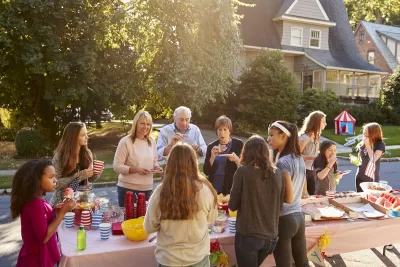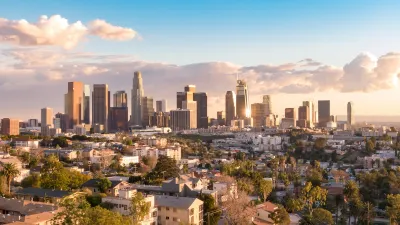How a humble neighborhood get-together can help build stronger cities.

In a piece for Strong Towns, Emma Durand-Wood offers “three reasons block parties are a highly valuable, underused tool for building stronger places.”
According to Durand-Wood, block parties have three important functions:
- Reducing fear and building trust: Block parties offer an opportunity to meet in a comfortable, casual environment with no agenda or polarizing issue. Too often people meet their neighbors when something goes wrong.
- Fostering community and creating agency: Getting to know neighbors can make a community more resilient to change and ready to act when needed. “Relationships built on a single issue may have some success in the short term. However, truly strong, powerful and enduring relationships are based on genuine interest, care and concern for your neighbors.”
- Dreaming big and starting small: One small event can help connect neighbors with similar interests and build long-term bonds that lead to further interaction.
As a bonus, Durand-Wood adds that block parties can also be a way for hard-working activists to restore and recharge among their neighbors and friends. Whether it’s an expansive event with street closures or a simple backyard barbecue, “The time we spend getting to know the people on our streets and in our neighborhoods, regardless of the scale of the gathering, is an investment that will never go to waste.”
FULL STORY: 3 Reasons Your Neighborhood Should Start Throwing Block Parties

Planetizen Federal Action Tracker
A weekly monitor of how Trump’s orders and actions are impacting planners and planning in America.

Congressman Proposes Bill to Rename DC Metro “Trump Train”
The Make Autorail Great Again Act would withhold federal funding to the system until the Washington Metropolitan Area Transit Authority (WMATA), rebrands as the Washington Metropolitan Authority for Greater Access (WMAGA).

The Simple Legislative Tool Transforming Vacant Downtowns
In California, Michigan and Georgia, an easy win is bringing dollars — and delight — back to city centers.

The Small South Asian Republic Going all in on EVs
Thanks to one simple policy change less than five years ago, 65% of new cars in this Himalayan country are now electric.

DC Backpedals on Bike Lane Protection, Swaps Barriers for Paint
Citing aesthetic concerns, the city is removing the concrete barriers and flexposts that once separated Arizona Avenue cyclists from motor vehicles.

In These Cities, Most New Housing is Under 441 Square Feet
With loosened restrictions on “micro-housing,” tiny units now make up as much as 66% of newly constructed housing.
Urban Design for Planners 1: Software Tools
This six-course series explores essential urban design concepts using open source software and equips planners with the tools they need to participate fully in the urban design process.
Planning for Universal Design
Learn the tools for implementing Universal Design in planning regulations.
Smith Gee Studio
City of Charlotte
City of Camden Redevelopment Agency
City of Astoria
Transportation Research & Education Center (TREC) at Portland State University
US High Speed Rail Association
City of Camden Redevelopment Agency
Municipality of Princeton (NJ)





























